Hole in the Clouds
Aug 30, 2009
The supply closet at the back of Tommy Flowers's math classroom at University Place Middle School in Tuscaloosa has won official recognition as the world's smallest museum.
Mr. Flowers, who has been teaching for 25 years, has assembled a collection of Edgar Allan Poe artifacts, including plastic hearts, dozens of photos, a skull, and of course, a skeleton. He says he became fascinated with Poe when he was himself in junior high school, and he tries to weave Poe's stories and poems into his students' daily lessons.
The fact that he teaches math, not literature, has not been an obstacle: he wants his students to take inspiration from Poe as they cultivate their imaginations to get the most out of life. Also, he wants them to calculate the square footage of his museum--the answer to that is 22, which is the magic number that got Edgar's Closet desgnated as smallest museum in the world.
"I d like a few visitors," said Mr. Flowers. "But more than anything, I'd like to see a few teachers have museums in their closets."
All five Stein boys went to University Place when it was an elementary school. It has recently added middle school grades as part of the Tuscaloosa City Board of Education's scheme to re-segregate the public schools. So far, there have been numerous complaints and petitions, but no lawsuits, so it's working.
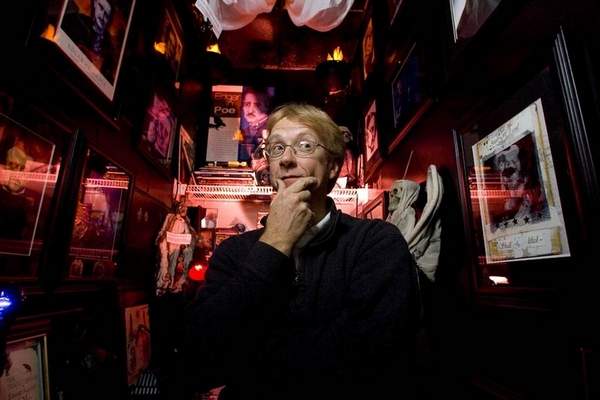
Tuscaloosa
Alabama
University Place School
museum
Edgar's closet
Tommy Flowers
Edgar Allan Poe
(Image credit: unknown)
Apr 1, 2013
 The noonday sun works its way into Beijing's new Capital Museum to illuminate China's ancient treasure.
The noonday sun works its way into Beijing's new Capital Museum to illuminate China's ancient treasure.
museum
China
Buddha
Beijing
(Image credit: Trey Ratcliff via Stuck in Customs)
Sep 13, 2013
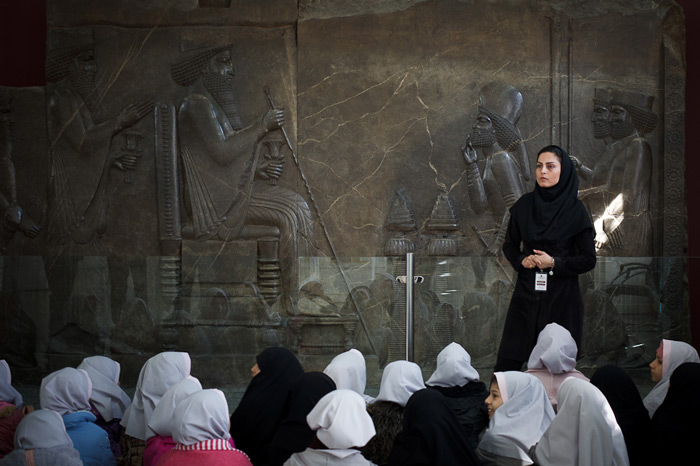 Schoolgirls in Tehran take a history lesson at the National Museum of Iran.
Schoolgirls in Tehran take a history lesson at the National Museum of Iran.
museum
Tehran
Iran
school
girls
National Museum of Iran
(Image credit: H. Tam)
Dec 22, 2013
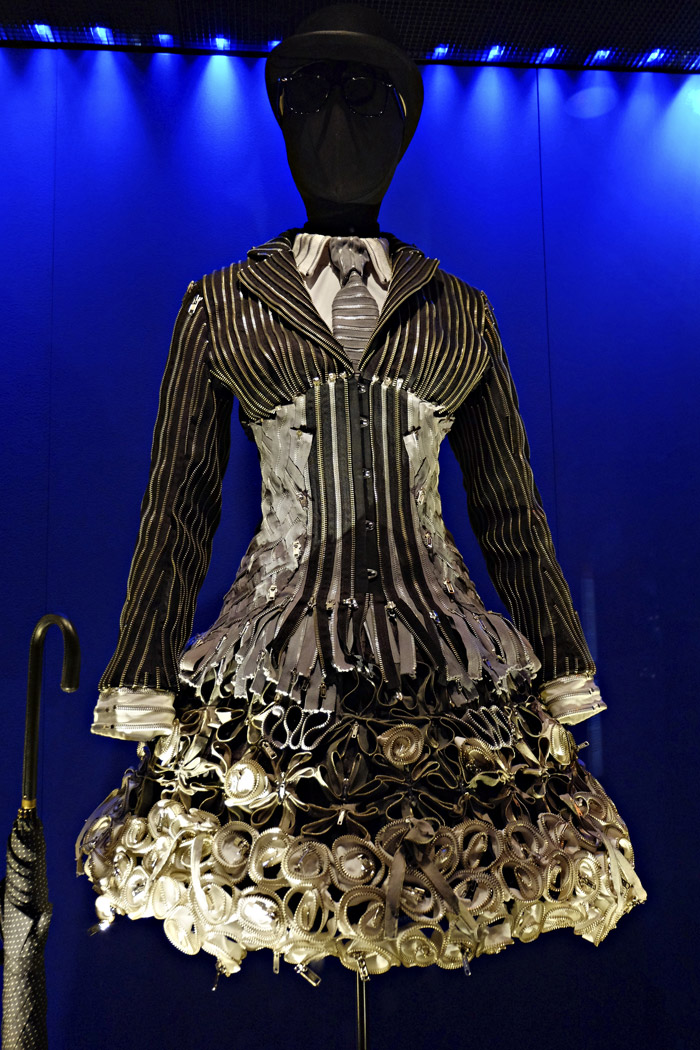 Among the happy occasions being celebrated recently while we were in New Zealand, in addition to the marriage of our niece, was the one hundredth anniversary of the invention of the zipper, as featured in the World of Wearable Art exhibition at Te Papa museum in Wellington.
Among the happy occasions being celebrated recently while we were in New Zealand, in addition to the marriage of our niece, was the one hundredth anniversary of the invention of the zipper, as featured in the World of Wearable Art exhibition at Te Papa museum in Wellington.
Elias Howe, inventor of the sewing machine, patented a zipper-like Automatic Continuous Clothing Closure in 1851 but was too busy selling sewing machines to get it to market.
Another zipper-like thingy, called a clasp locker by its inventor, Whitcomb Judson, was displayed at the 1893 Chicago World's Fair. It was designed to close boots with long rows of hooks and eyes, and it attracted investors who built a company around the idea but couldn't ever make it work.
Then in the early twentieth century a Swedish-born electrical engineer named Gideon Sundback married the daughter of the company president and was named chief designer. He spent seven years refining a different zipper-like device that by 1913 actually worked. But the company was still stuck in boot-closure mode, and for the next twenty years B.F. Goodrich was the main customer for zippers, which were used on a style of rubber galoshes known as "Zips."
It wasn't till the 1930s that zippers were sewn into ready-made clothing: at first, in children's wear, then for fly closures in men's trousers, and eventually in coats, skirts, dresses, luggage, sports gear, and everything else.
museum
New Zealand
art
Elias Howe
Gideon Sundback
Whitcomb Judson
Wellington
clothing
Te Papa
(Image credits: Little Fuji)
Jan 8, 2014
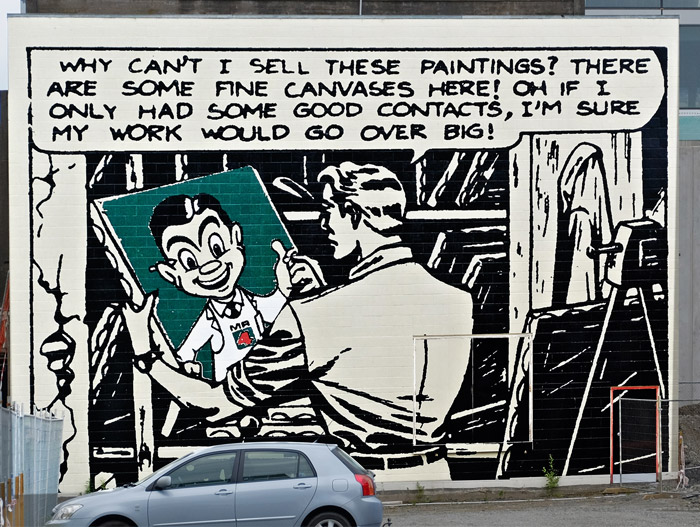 The little guy here in the white apron, with a pencil behind his ear–that's Mr. 4, the grocer-mascot of New Zealand's ubiquitous Four Square chain of supermarkets.
The little guy here in the white apron, with a pencil behind his ear–that's Mr. 4, the grocer-mascot of New Zealand's ubiquitous Four Square chain of supermarkets.
The mural featuring Mr. 4 covers a side wall of the art museum in Christchurch. The museum is closed at the moment and has been for a couple of years. All the artwork currently on exhibit is out in the streets of the city, like this piece.
Perhaps you are wondering why in the picture below there's a crane on top of the museum? Hold that thought; we'll get to it soon.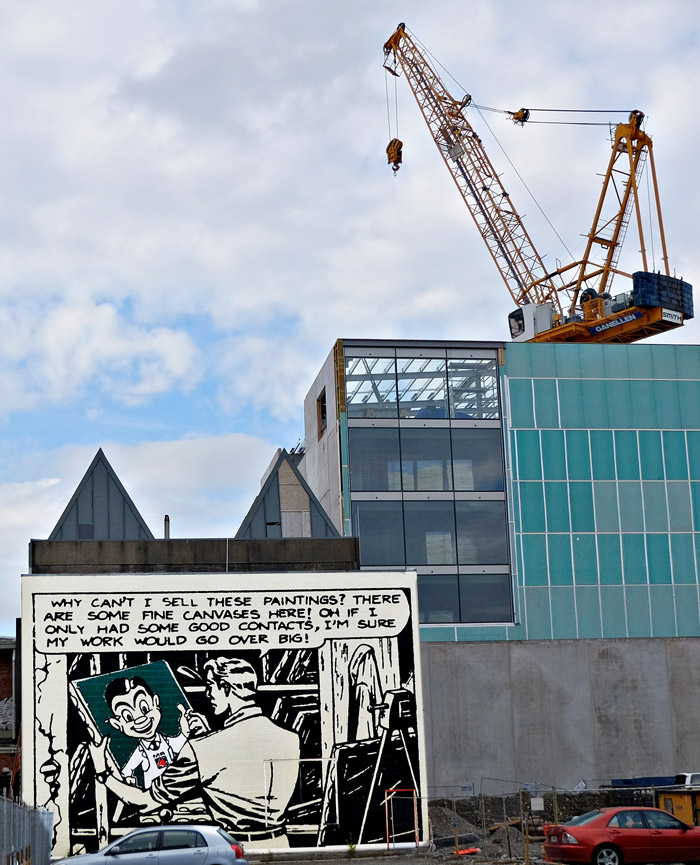
museum
New Zealand
art
streetscape
earthquake
mural
crane
grocery store
logo
Christchurch
(Image credit: Little Fuji)
Feb 23, 2015
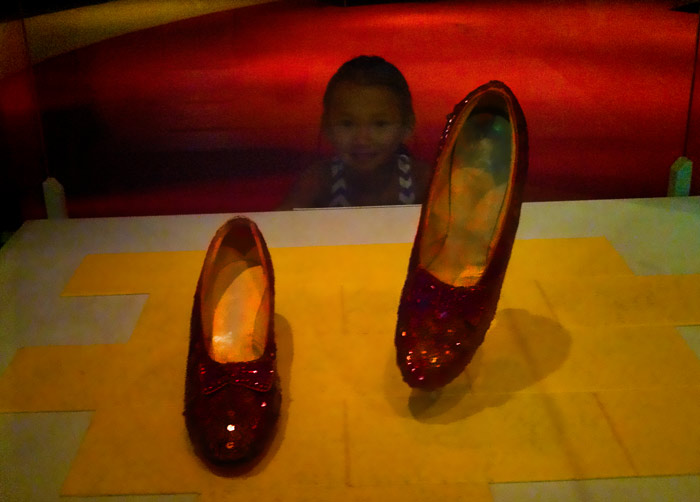 We might pause for a look at the real ruby slippers, once worn by a brave girl named Dorothy when she was far from home, now at rest in a glass case in the Smithsonian.
We might pause for a look at the real ruby slippers, once worn by a brave girl named Dorothy when she was far from home, now at rest in a glass case in the Smithsonian.
museum
Washington, D.C.
Dorothy
Lily
movie
Judy Garland
The Wizard of Oz
(Image credit: cellphone)
Mar 9, 2016
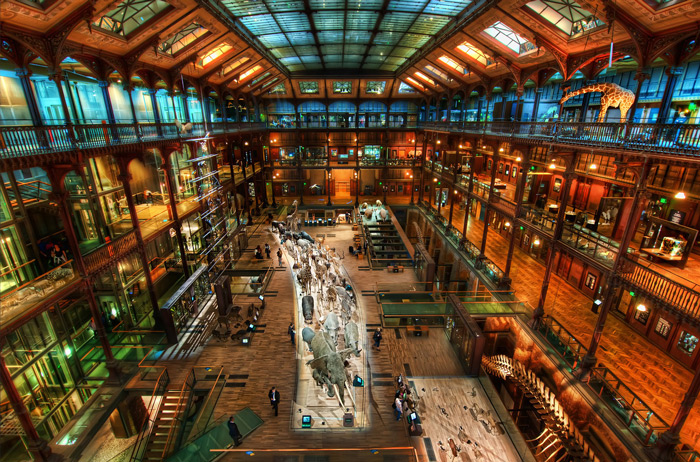 Also taxidermiferous! Displaying life that is no longer with us, at the Muséum national d'Histoire Naturelle in Paris.
Also taxidermiferous! Displaying life that is no longer with us, at the Muséum national d'Histoire Naturelle in Paris.
museum
animals
architecture
Paris
taxidermy
fossils
(Image credit: Trey Ratcliff via Stuck in Customs)





 The little guy here in the white apron, with a pencil behind his ear–that's Mr. 4, the grocer-mascot of New Zealand's ubiquitous Four Square chain of supermarkets.
The little guy here in the white apron, with a pencil behind his ear–that's Mr. 4, the grocer-mascot of New Zealand's ubiquitous Four Square chain of supermarkets.

